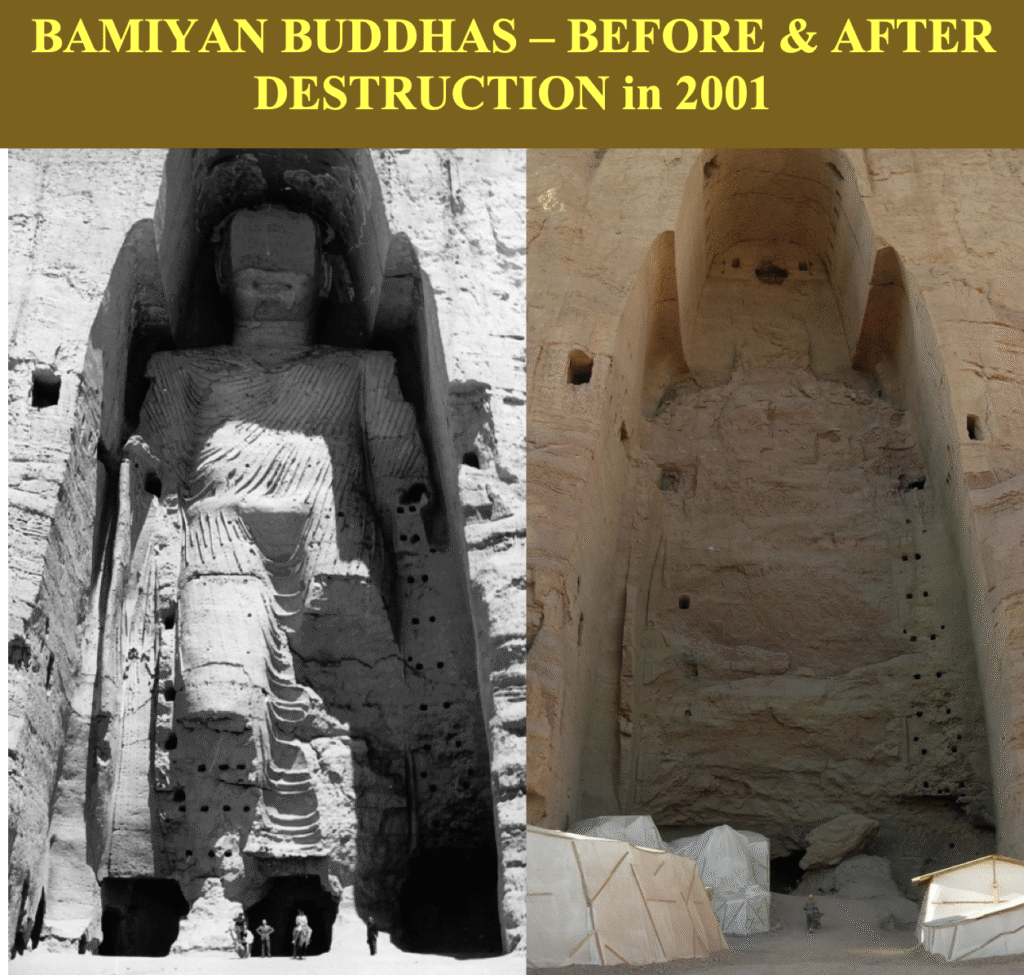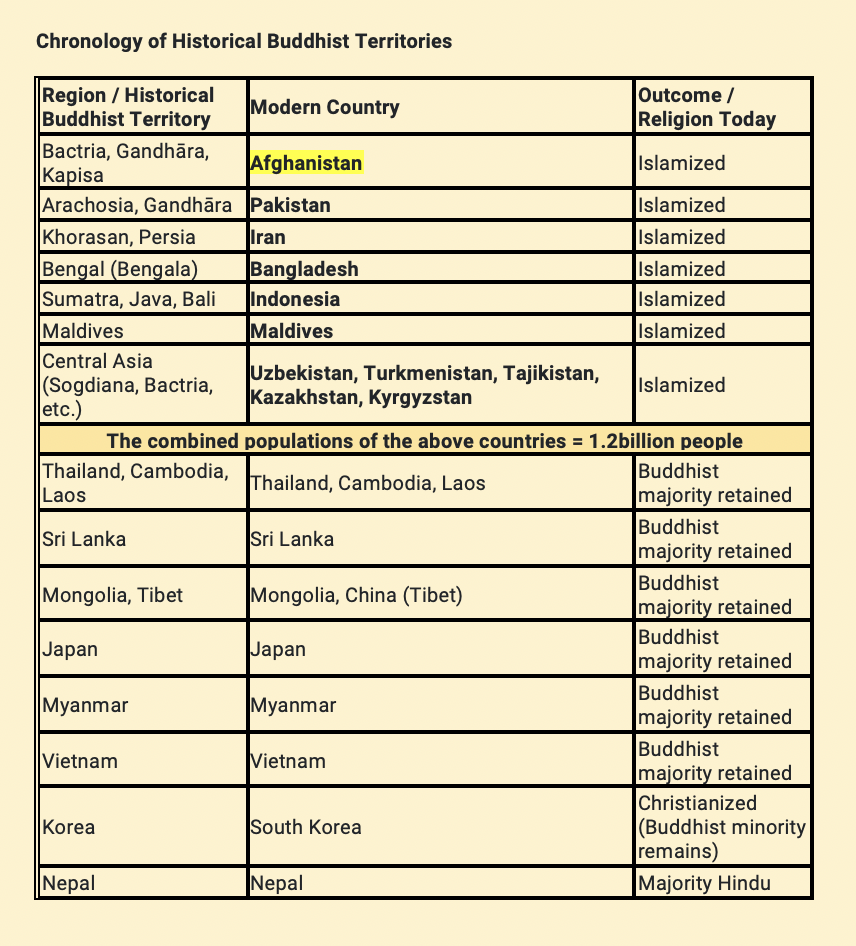Afghanistan: from Buddha’s Dhamma to Battlefields


Afghanistan is today remembered for suffering, oppression, war, militancy, opium, and foreign occupation. Yet for over 1,200 years Afghanistan was a center of Buddhism, known for its monasteries, universities, art, and trade. Few realize that the same land which today exports narcotics, terrorists and violence once produced statues of the Buddha, manuscripts of learning, and monks who carried knowledge across the Silk Road.
Afghanistan: First to Islamize
Afghanistan holds a unique place in history: it was among the first major Buddhist regions to experience Islamization.
The lands of present-day Afghanistan — spanning Bactria, Kapisa, Gandhāra, Balkh, Bamiyan, Mes Aynak, Hadda, Ghazni, and Jalalabad — were once a thriving network of Buddhist civilization.
Northern Afghanistan — today’s Balkh, Kunduz, Samangan, Baghlan, Takhar, and Jowzjan — formed the heart of Bactria, the cradle of Buddhist learning and culture. Monasteries, stupas, and universities flourished here, and the region was a hub of trade along the Silk Road, connecting India, Persia, and Central Asia.
Under the Mauryans and later the Kushan kings, Afghanistan became a vibrant center of Buddhist scholarship, Gandhāra art, and monastic life.
Ordinary people lived under values of compassion, non-violence, and learning, while women actively contributed to religious and cultural life.
By the 7th–10th centuries CE, Arab armies and subsequent Islamic rulers began altering this cultural landscape.
Monasteries were destroyed, monks dispersed or killed, and manuscripts burned.
Buddhism, once voluntarily embraced, disappeared, leaving behind only the ruins of its vast heritage.
Bactria (northern Afghanistan: Balkh, Kunduz, Samangan, Baghlan, Takhar, Jowzjan),
Gandhāra (eastern Afghanistan: Jalalabad, Peshawar in present-day Pakistan),
Population Perspective
Today, Afghanistan is nearly entirely Muslim, with 41 million people; under Buddhism, it might have reached 20–25 million in a culture of ethics, learning, and non-violence.
Buddhism’s Entry into Afghanistan
Before Buddhism, Afghanistan’s people followed the Indo-Iranian traditions, worshipping the sun, fire, and sky, and upholding ethical principles rooted in Zoroastrian and local practices.
When Buddhism arrived, its emphasis on compassion, non-violence, and moral responsibility resonated naturally with these pre-existing beliefs.
People embraced the Dhamma willingly, without coercion.
Buddhism entered Afghanistan through the efforts of Ashoka the Great, who extended the Mauryan Empire westward in the 3rd century BCE. His missionaries spread the teachings peacefully, offering guidance, education, and community support rather than imposing conversion by force.
Under the Kushan kings (1st–3rd centuries CE), Afghanistan became a flourishing Buddhist hub. Rulers such as Emperor Kanishka patronized monasteries, convened great Buddhist councils, constructed stupas, and promoted Gandhāra art. During this era, Afghanistan emerged as one of the most vibrant centers of Buddhist scholarship, culture, and trade in the world.
The People under Buddhism
For ordinary Afghans, Buddhism was not just philosophy — it was daily life.
Afghanistan’s people lived not under fear or oppression but under a culture of compassion and wisdom.
- Farmers cultivated their land under the guiding values of non-violence.
- Monasteries doubled as schools and guesthouses, giving villagers both education and refuge.
- Traders carried silk, lapis lazuli, and manuscripts, finding hospitality in Buddhist shrines along the Silk Road.
- Sculptors, painters, and artisans enriched communities with images that blended Greek, Persian, and Indian styles into the unique Gandhāra art.
- Festivals around stupas were gatherings of joy, learning, and community, not of war.
Chinese pilgrim Xuanzang, who visited in the 7th century, wrote of monasteries filled with monks, colossal Buddhas carved into cliffs, and bustling communities centered on learning and worship.
Women in Afghanistan: From Dharma to later eras
Under Buddhism
- Women played active roles in religious and scholarly life, studying Buddhist texts and participating in charitable work.
- They were patrons of monasteries, organizers of community festivals, and contributors to art and culture.
- Daily life allowed mobility, participation in public life, and personal expression, making Afghan communities vibrant and inclusive.
Later Eras
- Over time, with new social norms and changing governance, the roles and freedoms of women shifted. Historical records show cycles of restriction, particularly in conservative regions.
- Despite these changes, Afghan women continued to contribute to culture, family, and society wherever possible.
Malalai of Maiwant (1861-1880) is considered a national heroine taking a key role in the Second Anglo-Afghan war.
Queen Soraya Tarzi (1899-1968) was the first Queen of Afghanistan & wife of King Amanullah Khan who advocated for women’s education & rights.
1,200 Years of Buddhism in Afghanistan
- Balkhhoused the great Nava Vihara monastery.
- Bamiyancarved the largest standing Buddhas in the world.
- Mes Aynakcombined copper mining with monastic life.
- Hadda, Ghazni, Jalalabadwere centers of sculpture and learning.
Chinese pilgrims like Faxian and Xuanzang recorded the flourishing Buddhist communities of Afghanistan. Merchants carried lapis lazuli, silk, and manuscripts. The values of non-violence, education, and compassion were the social foundation of then Afghanistan.
From Dharma to Conquest
This order lasted until the 7th century CE, when Arab armies entered Herat and Sistan. Unlike the Mauryans, they came not with monks but with soldiers.
Over several centuries, Buddhist practices were systematically marginalized as Islam spread through conquest, social pressure, and state patronage
By the 10th century, Buddhism had disappeared from Afghanistan.
The people who once built monasteries were forced into mosques. Monks were dispersed or killed. Manuscripts were burned. To survive, Afghans had to submit, and in time they forgot the world their ancestors had lived in.
The Bamiyan Buddhas, though surviving for centuries, were finally dynamited in 2001. What could not be erased in 1,400 years of conquests was erased in modern times. From the time Islam entered Afghanistan, Buddhist monuments were treated as symbols of an older faith and therefore as threats to the new order.
As Mullah Mohammed Omar, the Taliban’s leader, declared in 2001:
“We smashed the idols of Bamiyan, and with their fragments built the mosque.”
The Buddhas stood as silent witnesses to Afghanistan’s Buddhist past, their very survival a challenge to those who wished to erase that memory.
The DNA of that Buddhist past remains in people still –
Afghanistan’s Treasures and Today’s Battles
As Buddhism declined and its ethical foundations eroded, Afghanistan became more vulnerable to conquest and the strategic plunder of its wealth.
Afghanistan’s mineral wealth — copper, lapis lazuli, rare earths — has always drawn foreign powers. In Buddhist times, these treasures funded monasteries and art. In modern times, they attracted Soviet occupation, US/NATO invasion, and global corporations.
Afghanistan also became synonymous with the opium trade, something unthinkable under Buddhist ethics, which prohibit intoxicants. What once exported sutras, art, and wisdom, today exports narcotics, terrorists and arms.
What once prohibited intoxicants now became the lifeblood of conflict economies
From Pilgrims to Pipelines
For over a thousand years, Afghanistan drew pilgrims and traders.
In modern times, it has drawn foreign armies. The Soviet Union came in 1979. The United States and NATO followed in 2001.
Both justified their invasions in political terms, yet behind the slogans lay the same reality: Afghanistan’s strategic wealth.
Its soil holds copper, lithium, rare earths, and oil. Its mountains are gateways for pipelines and energy corridors.
What was once a hub of Buddhist monasteries became a battleground for gas lines, oil lines, and mineral plunder.
The golden question – What if Buddhism had endured?
Had Afghanistan remained Buddhist, it is unlikely that:
- Opium fields would dominate its economy.
- Its cultural treasures would be reduced to rubble.
- It would be branded a “terror haven” and a testing ground for foreign invasions and corporate plunder.
Instead, Afghanistan might have been remembered like Nepal or Sri Lanka — as a land of monasteries, pilgrimage, and peace – a continued centre for cultural exploration, tourist arrivals and excursions.
Would the US and NATO have invaded a Buddhist Afghanistan?
Perhaps not so easily. Its minerals and routes would still tempt foreign powers, but without the excuse of terrorism, armies could not so readily justify occupation. The world may have come as investors and pilgrims, not as occupiers.
Lessons for Today
For 1,200 years, Afghans lived under Buddhism.
For 1,350 years, they have lived under Islam.
Nearly 3,000 years of Afghan history are split between two civilizations.
One was embraced voluntarily, the other imposed through conquest.
The Afghan people did not abandon Buddhism on their own — it was beaten out of them, burned from their texts, and blasted from their statues and erased from their minds.
Yet every time a Buddha fragment or a monastery ruin is unearthed, Afghanistan’s soil whispers: “We were once different. We were once gentle.”
Afghanistan’s past reminds us that civilizations can change — but they do not always change for the better. How a society treats knowledge, ethics, and compassion determines not only its own future but also how it is remembered by the world. History must be learnt and preserved, lest the lessons of a gentler past be lost to the violence of the present
Afghanistan’s Buddhist past reminds us that a society that cherishes knowledge, ethics, and compassion can thrive; a society that loses these values risks centuries of suffering.
As for the Remaining Buddhist Nations
The Buddhist nations that survived conquest — Thailand, Cambodia, Laos, Japan, Myanmar, Mongolia, Tibet, Vietnam and Sri Lanka — are fortunate, but survival alone does not guarantee adherence to the Buddha’s path. To truly honor their heritage, these nations must live the Dhamma in daily life: upholding compassion, non-violence, ethical governance, and societal wisdom.
History shows that labeling a nation as Buddhist is meaningless if society does not embody the Buddha’s Dhamma or risk moral decay & erosion of the culture it claims to protect.
Just as Sri Lanka has become a football field for geopolitical agendas and transnational capitalism, it also faces pressures to de-Buddhist itself through Islamization, Evangelical Christian influence, and Hindu expansion. These are additional threats to the Buddhist majority, for which the State must remain vigilant and take appropriate protective measures.
History has to be learnt and remembered so as not to repeat the same mistakes.
Shenali D Waduge







